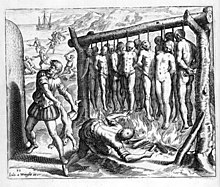Portal:Genocide/Selected article/5

The Genocide of indigenous peoples is the mass destruction of entire communities or races of indigenous peoples. Indigenous peoples are understood to be people whose historical and current territory has become occupied by colonial expansion, or the formation of a state by a dominant group such as a colonial power.
While the concept of genocide was formulated by Raphael Lemkin in the mid-20th century, the earlier expansion of various European colonial powers such as the Spanish and British empires, and the subsequent establishment of colonies on indigenous territory, frequently involved acts of genocidal violence against indigenous groups in the Americas, Australia, Africa and Asia. According to Lemkin, colonization was in itself "intrinsically genocidal". He saw this genocide as a two-stage process, the first being the destruction of the indigenous population's way of life. In the second stage, the newcomers impose their way of life on the indigenous group. According to David Maybury-Lewis, imperial and colonial forms of genocide are enacted in two main ways, either through the deliberate clearing of territories of their original inhabitants in order to make them exploitable for purposes of resource extraction or colonial settlements, or through enlisting indigenous peoples as forced laborers in colonial or imperialist projects of resource extraction. The designation of specific events as genocidal is often controversial.
Some scholars, among them Lemkin, have argued that cultural genocide, sometimes called ethnocide, should also be recognized. A people may continue to exist, but if they are prevented from perpetuating their group identity by prohibitions against cultural and religious practices that are the basis of that identity, this may also be considered a form of genocide. Examples include the treatment of Tibetans by the Chinese government and Native Americans by the US government
